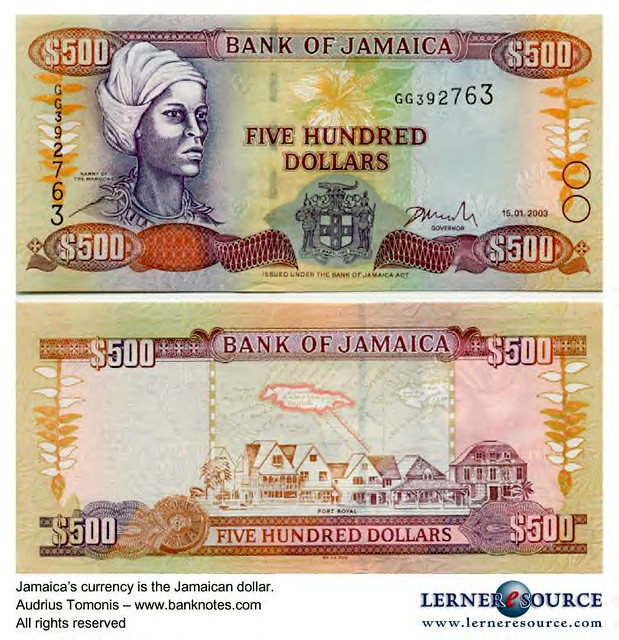

Their notes were released on May 1, 1961, in the denominations of 5s, 10s, £1, and £5. In October 1960, the Bank of Jamaica was given the sole right to mint coins and produce banknotes in Jamaica.

In 1940, the government bank began producing £1 and £5 notes. The 2s 6d note proved to have a short life, being withdrawn in 1922. In 1918, denominations of 2s 6d and 5s were authorized. Banknotes of £1 and £5 were also being circulated by chartered banks. In 1904, the first government-authorized banknotes were produced in the denomination of 10s. Beginning in 1880, the farthing was also minted in cupronickel. Pennies and halfpennies were minted for use in Jamaica, becoming the first truly Jamaican coins. The solution was to use cupronickel, adopted in 1869. The emancipation of the slaves in 1838 increased the need for coinage in Jamaica, particularly low-denomination coins, but the blacks were still reluctant to use copper. Coins in use were thus the farthing ( 1⁄ 4d), halfpenny, penny, three halfpence ( 1 + 1⁄ 2d), threepence, sixpence, shilling, florin (2s), half crown (2s 6d), and crown (5s). In 1839, an act was passed by Parliament declaring that as of December 31, 1840, only British coinage would be legal tender in Jamaica, demonetizing all of the Spanish coins, with the exception of the gold doubloon which was valued at £3 4s. Hence, they came to be called "Christian quatties". These in particular were used in church collections due to a feeling by the black population that copper coins were inappropriate for that purpose. The three-halfpence coins came to be called "quartiles" or "quatties". In 1834, silver coins of threepence and three halfpence ( 1 + 1⁄ 2 pence) were introduced, valued at 1⁄ 2 real and 1⁄ 4 real. The common link between these four territories was the Bank of Nova Scotia which brought in the 'Maccaroni' tradition, resulting in the successful introduction of both sterling coinage and sterling accounts.


However, in Jamaica, British Honduras, Bermuda, and later in the Bahamas also, the official rating was set aside in favour of what was known as the 'Maccaroni' tradition in which a British shilling, referred to as a 'Maccaroni', was treated as one quarter of a dollar. Remedial legislation had to be introduced in 1838 so as to change over to the more realistic rating of $1 = 4s 2d. It had the effect of actually driving sterling coinage out, rather than encouraging its circulation. As the sterling silver coins were attached to a gold standard, this exchange rate did not realistically represent the value of the silver in the Spanish dollars as compared to the value of the gold in the British gold sovereign, and as such, the order-in-council had the reverse effect in many colonies. The United Kingdom had adopted a very successful gold standard in 1821, so 1825 was an opportune time to introduce the British sterling coinage into all the British colonies.Īn imperial order-in-council was passed in that year for the purposes of facilitating this aim by making sterling coinage legal tender in the colonies at the specified rating of $1 = 4s 4d (one Spanish dollar to four shillings and four pence sterling). The last Spanish dollar was minted at the Potosí mint in 1825. However, following the revolutionary wars in Latin America, the source of these silver trade coins dried up. This relates to the fact that for nearly four hundred years Spanish dollars, known as pieces of eight were in widespread use on the world's trading routes, including the Caribbean Sea region. The earliest money in Jamaica was Spanish copper coins called maravedíes. The peculiar feature about Jamaica was the fact that it was the only British West Indies territory to use special issues of the sterling coinage, apart from the four-pence groat coin which was specially issued for all the British West Indies, and later only for British Guiana. The history of currency in Jamaica should not be considered in isolation of the wider picture in the British West Indies as a whole. Goods and services may still be priced in cents, but cash transactions are now rounded to the nearest dollar.Įxchange rate Current JMD exchange rates It is divided into 100 cents, although cent denominations are no longer in use as of 2018. It is often abbreviated to J$, the J serving to distinguish it from other dollar-denominated currencies. The Jamaican dollar ( sign: $ code: JMD) has been the currency of Jamaica since 1969.


 0 kommentar(er)
0 kommentar(er)
